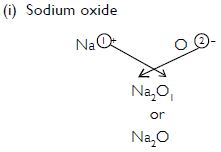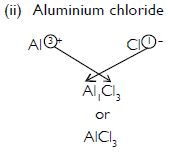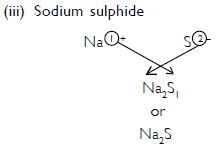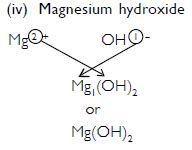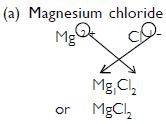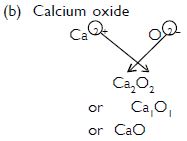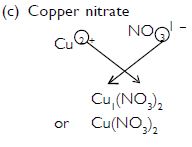Question 1:
In a reaction, 5.3 g of sodium carbonate reacted with 6 g of ethanoic acid. The products were
2.2 g of carbon dioxide, 0.9 g water and 8.2 g of sodium acetate. Show that these
observations are in agreement with the law of conservation of mass.
Sodium carbonate + Ethanoic acid Sodium acetate + Carbon dioxide + Water
Answer:
Mass of sodium carbonate = 5.3 g
Mass of ethanoic acid = 6.0 g
Total mass of the reactants = 5.3 + 6.0
= 11.3 g
Mass of carbon dioxide = 2.2 g
Mass of water = 0.9 g
Mass of sodium ethanoate = 8.2 g
Total mass of the products = 2.2 + 0.9 + 8.2
= 11.3 g
Total mass of the reactants = Total mass of the products
Thus, law of conservation of mass is followed.
Question 2:
Hydrogen and oxygen combine in the ratio of 1 : 8 by mass to form water. What mass of oxygen gas would be required to react completely with 3 g of hydrogen?
Answer:
Mass of oxygen gas that reacts with 1 g of hydrogen gas = 8 g
Mass of oxygen gas that reacts with 3 g of oxygen gas = 3 × 8 = 24 g
Question 3:
Which postulate of Dalton’s atomic theory is the result of the law of conservation of mass?
Answer:
Atoms are indivisible particles and can neither be created nor destroyed during any physical or chemical reaction.
Question 4:
Which postulate of Dalton’s atomic theory can explain the law of definite proportions?
Answer:
Atoms of various elements combine in the simple whole number ratio to form compounds.
Question 5:
Define the atomic mass unit.
Answer:
Atomic mass unit is a mass unit and it is equal to
of mass of an atom of carbon-12.
1 a.m.u. = 1.66 × 10–27 kg
Question 6:
Why is it not possible to see an atom with naked eyes?
Answer:
This is because atoms are very–very small. The radius of an atom is of the order of 10–10 m.
Question 7:
Write down the formulae of
(i) Sodium oxide (ii) Aluminium chloride
(iii) Sodium sulphide (iv) Magnesium hydroxide
Answer:
Question 8:
Write down the names of the compounds represented by the following formulae:
(i) Al2(SO4)3
(ii) CaCl2
(iii) K2SO4
(iv) KNO3
(v) CaCO3
Answer:
(i) Aluminium sulphate (ii) Calcium chloride
(iii) Potassium sulphate (iv) Potassium nitrate
(v) Calcium carbonate
Question 9:
What is meant by the term chemical formula?
Answer:
Chemical formula: The chemical formula of a substance indicates its constituent elements and number of atoms of each combining element present in one molecule of it.
Question 10:
How many atoms are present in a
(i) H2S molecule and
(ii)
Answer:
(i) An H2S molecule has two atoms of hydrogen and one atom of sulphur.
(ii) A
ion has one atom of phosphorus and three atoms of oxygen.
Question 11:
Calculate the molecular masses of H2 , O2 , Cl2 , CO2 , CH4 , C2 H6 , C2 H4 , NH3 , CH3 OH.
Answer:
Molecular mass of H2 = 2 × 1 = 2 u
Molecular mass of O2 = 2 × 16 = 32 u
Molecular mass of Cl2 = 2 × 35.5 = 71.0 u
Molecular mass of CO2 = 1 × 12 + 2 × 16 = 12 + 32 = 44 u
Molecular mass of CH4 = 12 + 4 × 1 = 12 + 4 = 16 u
Molecular mass of C2H6 = 2 × 12 + 6 × 1 = 24 + 6 = 30 u
Molecular mass of C2H4 = 2 × 12 + 4 × 1 = 24 + 4 = 28 u
Molecular mass of NH3 = 14 + 3 × 1 = 14 + 3 = 17 u
Molecular mass of CH3OH = 12 + 3 × 1 + 16 + 1 = 12 + 3 + 16 + 1 = 32 u
Question 12:
Calculate the formula unit masses of ZnO, Na2O, K2CO3, given atomic masses of Zn = 65 u, Na = 23 u, K = 39 u, C = 12 u and O = 16 u.
Answer:
Formula unit mass of ZnO = 65 + 16
= 81 u
Formula unit mass of Na2O = 2 × 23 + 16 = 46 + 16 = 62 u
Formula unit mass of K2CO3 = 2 × 39 + 12 + 3 × 16 = 78 + 12 + 48 = 138
u
Question 13:
If one mole of carbon atoms weighs 12 gram, what is the mass (in grams) of 1 atom of carbon
Answer:
1 mole of carbon has mass = 12 g
\ Mass of 1 atom of carbon =
= 1.99 × 10–23 g
Question 14:
Which has more number of atoms, 100 grams of sodium or 100 grams of iron (Given, atomic mass of Na = 23 u, Fe = 56 u)?
Answer:
Mass of sodium = 100 g
Atomic mass of sodium = 23 u
Mass of 1 mole of sodium = 23 g
No. of moles of sodium in 100 g =
No. of atoms of sodium in 100 g =
=
= 0.262 × 10–25
= 2.62 × 10–24
Mass of Fe = 100 g
Atomic mass of Fe = 56 u
Mass of 1 mole of Fe = 56 g
No. of moles of Fe in 100 g =
=
No. of atoms of Fe in 100 g =
=
= 10.754 × 10–23
= 1.0754 × 10–24
100 g of sodium has more number of atoms.
Question 15:
A 0.24 g sample of compound of oxygen and boron was found by analysis to contain 0.096 g of boron and 0.144 g of oxygen. Calculate the percentage composition of the compound by weight.
Answer:
Weight of compound = 0.24 g
Weight of Boron = 0.096 g
Weight of oxygen = 0.144 g
\ % of B =
% of O =
Question 16:
When 3.0 g of carbon is burnt in 8.00 g oxygen, 11.00 g of carbon dioxide is produced. What mass of carbon dioxide will be formed when 3.00 g of carbon is burnt in 50.00 g of oxygen? Which law of chemical combination will govern your answer?
Answer:
3.00 g of carbon combines with 8.00 g of oxygen to produce 11.00 g of carbon dioxide.
C + O2 CO2
When 3.00 g of carbon is burnt in 50.00 g of oxygen, 11.00 g of carbon dioxide is produced.
This is based upon the law of constant compositions.
Question 17:
What are polyatomic ions? Give examples.
Answer:
Polyatomic ion: A group of atoms carrying a charge (+ve or –ve) is called a polyatomic ion.
Examples :
Question 18:
Write the chemical formulae of the following:
(a) Magnesium chloride (b) Calcium oxide
(c) Copper nitrate (d) Aluminium chloride
(e) Calcium carbonate
Answer:
Question 19:
Give the names of the elements present in the following compounds:
(a) Quick lime (b) Hydrogen bromide
(c) Baking powder (d) Potassium sulphate
Answer:
(a) Quick lime (CaO): The elements present in it are calcium and oxygen.
(b) Hydrogen bromide (HBr): The elements present in it are hydrogen and bromine.
(c) Baking powder (NaHCO3): The elements present in it are sodium, hydrogen,
carbon and oxygen.
(d) Potassium sulphate (K2SO4): The elements present in it are
potassium, sulphur and oxygen.
Question 20:
Calculate the molar mass of the following substances:
(a) Ethyne, C2H2 (b) Sulphur molecule, S8
(c) Phosphorus molecule, P4 (Atomic mass of phosphorus is 31)
(d) Hydrochloric acid, HCl (e) Nitric acid, HNO3
Answer:
(a) Molar mass of ethyne, C2H2 = 2 × 12 + 2 × 1 = 24 + 2 = 26 g
(b) Molar mass of sulphur molecule, S8 = 8 × 32 = 256 g
(c) Molar mass of phosphorus molecule, P4 = 4 × 31 = 124 g
(d) Molar mass of hydrochloric acid, HCl = 1 + 35.5 = 36.5 g
(e) Molar mass of nitric acid, HNO3 = 1 + 14 + 3 × 16 = 1 + 14 + 48
= 63 g
Question 21:
What is the mass of
(a) 1 mole of nitrogen atom?
(b) 4 moles of aluminium atoms (Atomic mass of aluminium = 27)?
(c) 10 moles of sodium sulphite (Na2SO3)?
Answer:
(a) Molar mass of ethyne, C2H2 = 2 × 12 + 2 × 1 = 24 + 2 = 26 g
(b) Molar mass of sulphur molecule, S8 = 8 × 32 = 256 g
(c) Molar mass of phosphorus molecule, P4 = 4 × 31 = 124 g
(d) Molar mass of hydrochloric acid, HCl = 1 + 35.5 = 36.5 g
(e) Molar mass of nitric acid, HNO3 = 1 + 14 + 3 × 16 = 1 + 14 + 48
= 63 g
Question 22:
What is the mass of
(a) 1 mole of nitrogen atom?
(b) 4 moles of aluminium atoms (Atomic mass of aluminium = 27)?
(c) 10 moles of sodium sulphite (Na2SO3)?
Answer:
(a) Mass of 1 mole of N atoms = 14 g
(b) Mass of 1 mole of Al atoms = 27 g
Mass of 4 moles of Al atoms = 4 × 27 = 108 g
(c) Mass of 1 mole of sodium sulphite, Na2SO3
= 2 × 23 + 32 + 3 × 16
= 46 + 32 + 48 = 126 g
Mass of 10 moles of Na2SO3 = 10 × 126 = 1260 g
Question 23:
Convert into moles:
(a) 12 g of oxygen gas
(b) 20 g of water
(c) 22 g of carbon dioxide
Answer:
We know that, the number moles of a substance, n =
(a) No. of moles in 12 g of oxygen gas (O2) =
(b) No. of moles in 20 g of water (H2O) =
(c) No. of moles in 22 g of carbon dioxide
(CO2) = 
Question 24:
What is the mass of:
(a) 0.2 mole of oxygen atoms?
(b) 0.5 mole of water molecules?
Answer:
(a) 0.2 mole of oxygen atoms:
Mass of 1 mole of oxygen atoms = 16 g
Mass of 0.2 mole of oxygen atoms = 0.2 × 16 = 3.2 g
(b) 0.5 mole of water molecules:
Mass of 1 mole of water molecule (H2O) = 18 g
Mass of 0.5 mole of water molecules = 0.5 × 18 = 9 g
Question 25:
Calculate the number of molecules of sulphur (S8) present in 16 g of solid sulphur.
Answer:
Mass of solid sulphur (S8) = 16 g
Mass of 1 mole of sulphur (S8) = 8 × 32 = 256 g
No. of atoms in 16 g of solid sulphur =
= 3.0115 × 1023
Question 26:
Calculate the number of aluminium ions present in 0.051 g of aluminium oxide.
Answer:
(Hint: The mass of an ion is the same as that of an atom of the same element. Atomic mass of
Al = 27 u)
Molar mass of aluminium oxide,


